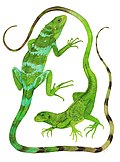Ctenosaura melanosterna
| Ctenosaura melanosterna | |
|---|---|

| |
| Black-chested spiny-tailed iguana | |
| Scientific classification | |
| Domain: | Eukaryota |
| Kingdom: | Animalia |
| Phylum: | Chordata |
| Class: | Reptilia |
| Order: | Squamata |
| Suborder: | Iguania |
| Family: | Iguanidae |
| Genus: | Ctenosaura |
| Species: | C. melanosterna
|
| Binomial name | |
| Ctenosaura melanosterna Buckley & Axtell, 1997
| |

| |
Ctenosaura melanosterna, commonly known as the black-chested spiny-tailed iguana or Honduran spinytailed iguana, is a species of iguana in the genus Ctenosaura. It is considered endangered.[3]
Geographic range
The black-chested spiny-tailed iguana is
Habitat
The natural habitat of the black-chested spiny-tailed iguana is the
Threats
There are a few reasons as to why the black-chested spiny-tailed iguana is endangered, but the most significant reason is human activity.[3] Threats from humans include from hunting, trading, and habitat destruction and fragmentation.[3][4] The forests in which the iguanas live are being cleared, mainly for agricultural purposes.[3] The iguanas and their eggs are poached for human consumption as well.[5] In addition, the Green iguana is also much more numerous throughout Central America, making it a competitor for food and resources.
References
- . Retrieved 16 November 2021.
- ^ "Appendices". cites.org. Retrieved 2022-01-14.
- ^ a b c d e "Ctenosaura melanosterna". IUCN. February 19, 2024.
- ^ Pasachnik, Stesha A.; Montgomery, Chad E.; Ruyle, Leslie E.; Corneal, Jeffrey P.; Antunez, Edoardo E. (31 December 2012). "Morphological and Demographic Analyses of the Blackchested Spiney-tailed Iguana, Ctenosaura melanosterna, Across Their Range: Implications for Population Level Management". Herpetogical Biology and Conservation. 7 (3): 399–406.
- ^ Montgomery, Chad E., S. A. Pasaschnik, L. E. Ruyle, J. A. Frazier, and S. E. W. Green. 2014. Natural History of the Black-Chested Spiny-Tailed Iguanas, Ctenosaura melanosterna (Igunaidae), on Cayo Cochino Menor, Honduras. The Southwestern Naturalist 59:280–285.
Further reading
- Buckley, L.J., and R.W. Axtell. 1997. Evidence for the Specific Status of the Honduran Lizards Formerly Referred to Ctenosaura palearis (Reptilia: Squamata: Iguanidae). Copeia 1997 (1): 138–150.
- Montgomery, Chad E., S. A. Pasaschnik, L. E. Ruyle, J. A. Frazier, and S. E. W. Green. 2014. Natural History of the Black-Chested Spiny-Tailed Iguanas, Ctenosaura melanosterna (Igunaidae), on Cayo Cochino Menor, Honduras. The Southwestern Naturalist 59:280–285.


